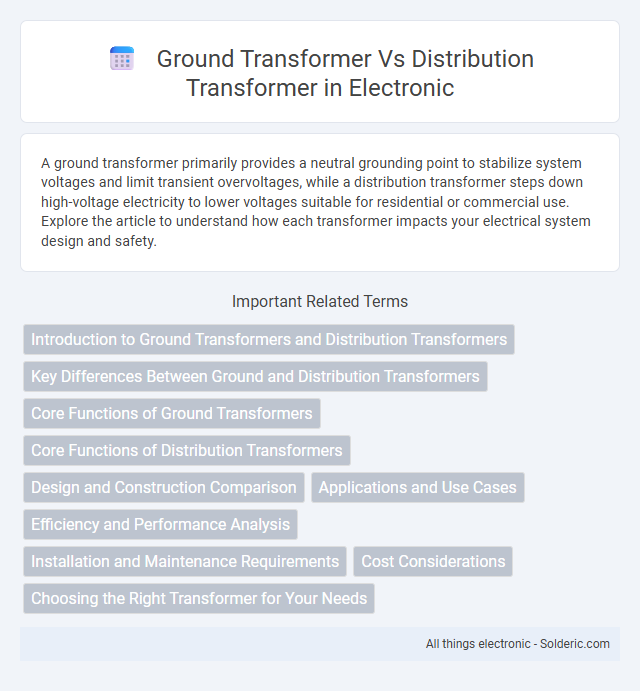A ground transformer primarily provides a neutral grounding point to stabilize system voltages and limit transient overvoltages, while a distribution transformer steps down high-voltage electricity to lower voltages suitable for residential or commercial use. Explore the article to understand how each transformer impacts your electrical system design and safety.
Comparison Table
| Feature | Ground Transformer | Distribution Transformer |
|---|---|---|
| Primary Purpose | Neutral grounding in power systems | Voltage step-down for general power distribution |
| Function | Limits ground fault current, stabilizes system voltage | Converts high voltage to low voltage for end-users |
| Connection | Connected between neutral and ground | Connected between primary high voltage and secondary low voltage lines |
| Voltage Rating | Typically low voltage, designed for fault conditions | Varies; common ratings 11kV/415V or 33kV/415V |
| Application | Power system protection and grounding | Power distribution to residential, commercial, industrial loads |
| Construction | May use zig-zag or star winding for neutral grounding | Core and coil design optimized for energy efficiency and load |
| Load Handling | Handles short-duration fault currents | Handles continuous load currents |
| Cost | Lower cost due to specialized function | Higher cost due to larger size and load capacity |
Introduction to Ground Transformers and Distribution Transformers
Ground transformers provide a reliable grounding point in electrical systems, ensuring stability and safety by preventing voltage surges and fault currents. Distribution transformers, designed for voltage conversion, efficiently step down high voltage from power lines to usable levels for residential or commercial use. Understanding the distinct roles of these transformers helps optimize your electrical system's performance and safety.
Key Differences Between Ground and Distribution Transformers
Ground transformers primarily serve to provide a neutral grounding point in electrical systems, enhancing safety by stabilizing voltage during faults, whereas distribution transformers focus on stepping down high voltage to usable levels for residential or commercial loads. Ground transformers typically handle lower power ratings and are not designed for continuous load, unlike distribution transformers which support continuous energy distribution with higher capacity and efficiency. Your choice between the two depends on the specific application requirements, including system protection and load demands.
Core Functions of Ground Transformers
Ground transformers primarily serve to provide a stable neutral grounding point in electrical distribution systems, enabling the safe dissipation of fault currents and preventing equipment damage. They ensure system protection by facilitating the proper operation of protective relays during ground faults and maintaining voltage stability. Your electrical infrastructure relies on ground transformers to enhance safety and continuity by managing unbalanced currents effectively.
Core Functions of Distribution Transformers
Distribution transformers primarily function to step down high-voltage electricity from the power grid to lower voltages suitable for residential and commercial use. They ensure efficient voltage regulation and maintain consistent power quality to prevent damage to electrical appliances. Unlike ground transformers, which serve grounding and load-sharing roles in electrical systems, distribution transformers are integral to the final voltage transformation stage in power distribution.
Design and Construction Comparison
Ground transformers typically feature a robust design with a grounding winding to stabilize ungrounded systems, ensuring safety during ground faults, while distribution transformers prioritize efficient voltage regulation for delivering electrical power to end-users. The construction of ground transformers includes reinforced insulation and grounding coils to handle fault currents, whereas distribution transformers emphasize core design and coil arrangements optimized for energy loss reduction and voltage transformation. Your choice between the two should consider the specific requirements of system grounding versus power distribution needs.
Applications and Use Cases
Ground transformers are primarily used to provide a neutral grounding point in high-voltage power systems, ensuring system stability and fault protection by limiting transient overvoltages. Distribution transformers serve to step down voltage levels from medium to low voltage for direct use in residential, commercial, and industrial applications, facilitating safe delivery of electricity to end-users. Your choice between these transformers depends on whether the priority is system grounding for safety or voltage conversion for power distribution.
Efficiency and Performance Analysis
Ground transformers typically exhibit lower efficiency compared to distribution transformers due to their specialized role in providing a reference ground point and handling fault currents rather than continuous power delivery. Distribution transformers are designed for optimal performance in power transfer, achieving efficiency levels often exceeding 98% by minimizing losses through advanced core materials and winding configurations. Performance analysis reveals that distribution transformers maintain stable voltage regulation and lower thermal losses under varying load conditions, while ground transformers prioritize safety and system stability over efficiency metrics.
Installation and Maintenance Requirements
Ground transformers require specialized installation involving grounding grids or rods to ensure safe fault current dissipation, while distribution transformers are generally installed on poles or pads with standardized mounting setups. Maintenance of ground transformers demands regular checks for grounding integrity and insulation resistance to prevent earth faults, whereas distribution transformers focus on oil level monitoring, cooling system checks, and routine load assessments. Both types necessitate adherence to electrical safety standards, but ground transformers often involve more complex grounding system inspections.
Cost Considerations
Ground transformers generally have a lower initial cost compared to distribution transformers due to their simpler construction and specific function in grounding systems. Distribution transformers, designed for voltage regulation and power distribution, tend to incur higher costs from advanced materials and enhanced efficiency features essential for end-user applications. Your choice should balance budget constraints with performance requirements, recognizing that investment in a quality distribution transformer can reduce long-term maintenance and energy costs.
Choosing the Right Transformer for Your Needs
Selecting the right transformer depends on your project's specific requirements, such as voltage levels and grounding methods. Ground transformers provide a neutral point for grounding and are ideal for stabilizing ungrounded systems, while distribution transformers step down voltage from high to usable levels for residential or commercial use. Understanding your system's electrical needs ensures your transformer choice optimizes performance and safety.
ground transformer vs distribution transformer Infographic

 solderic.com
solderic.com